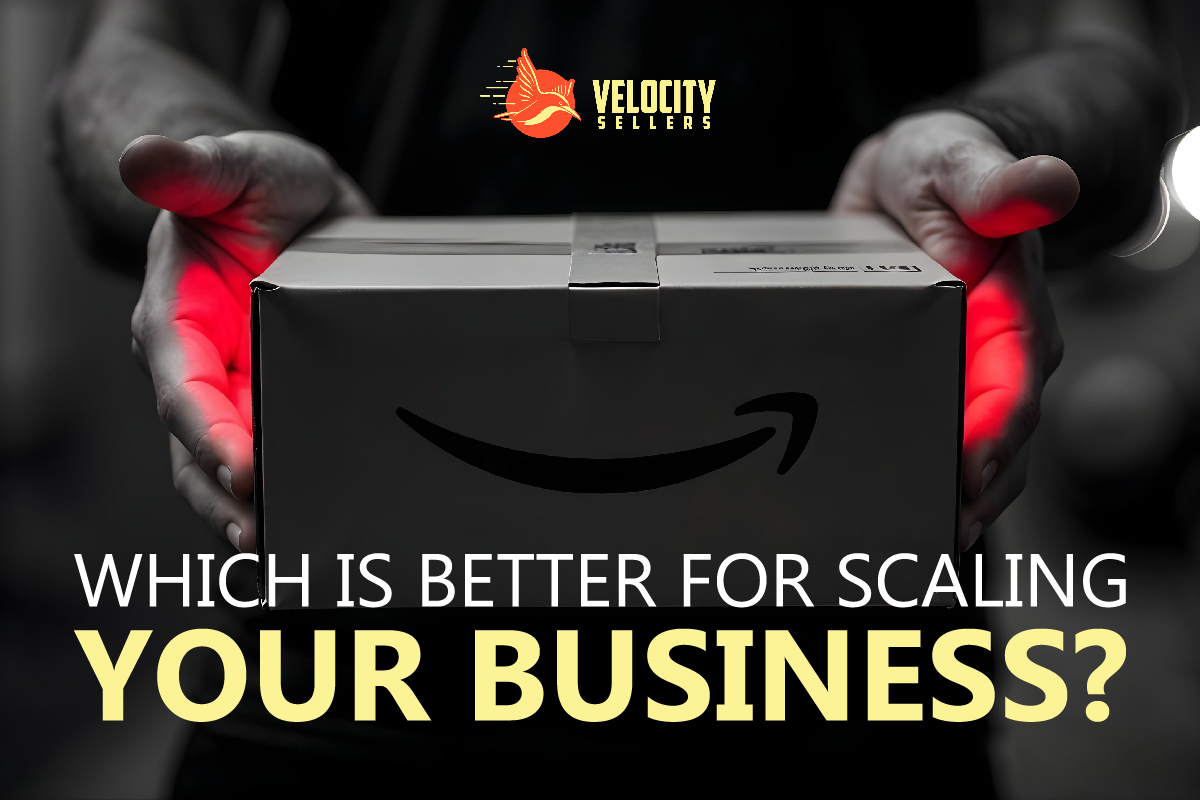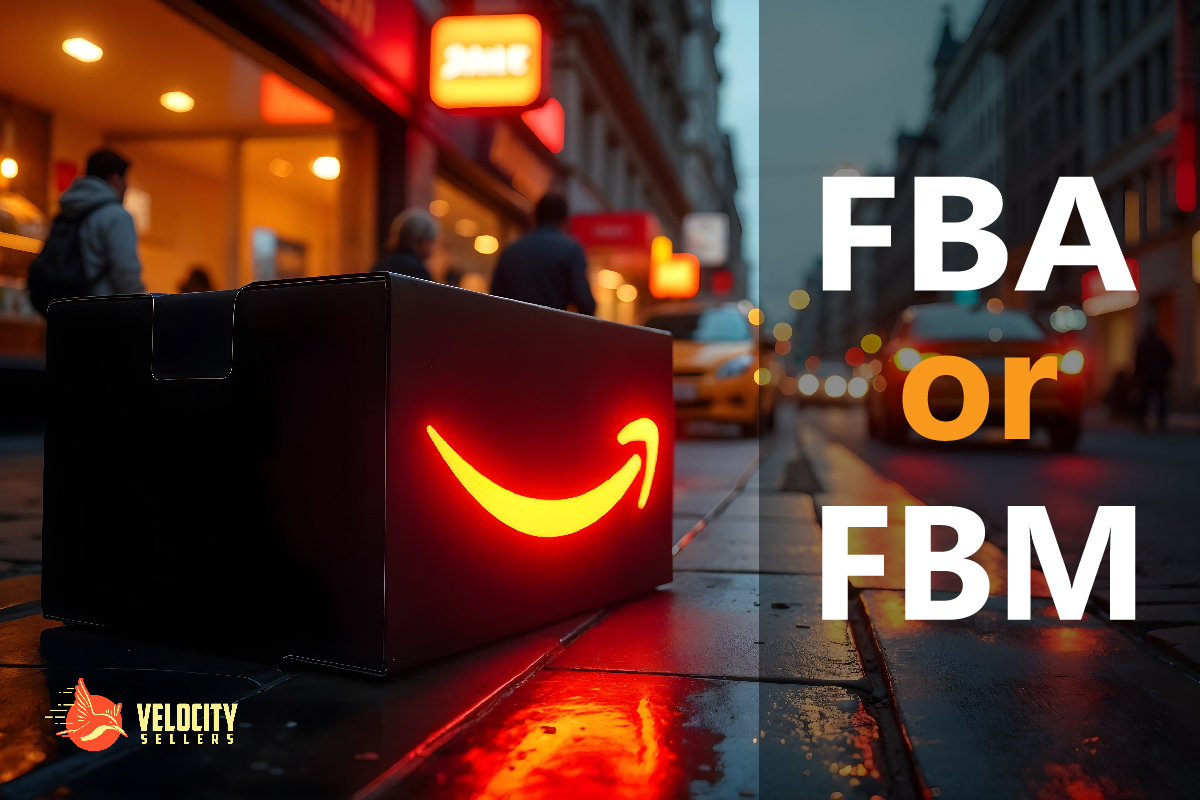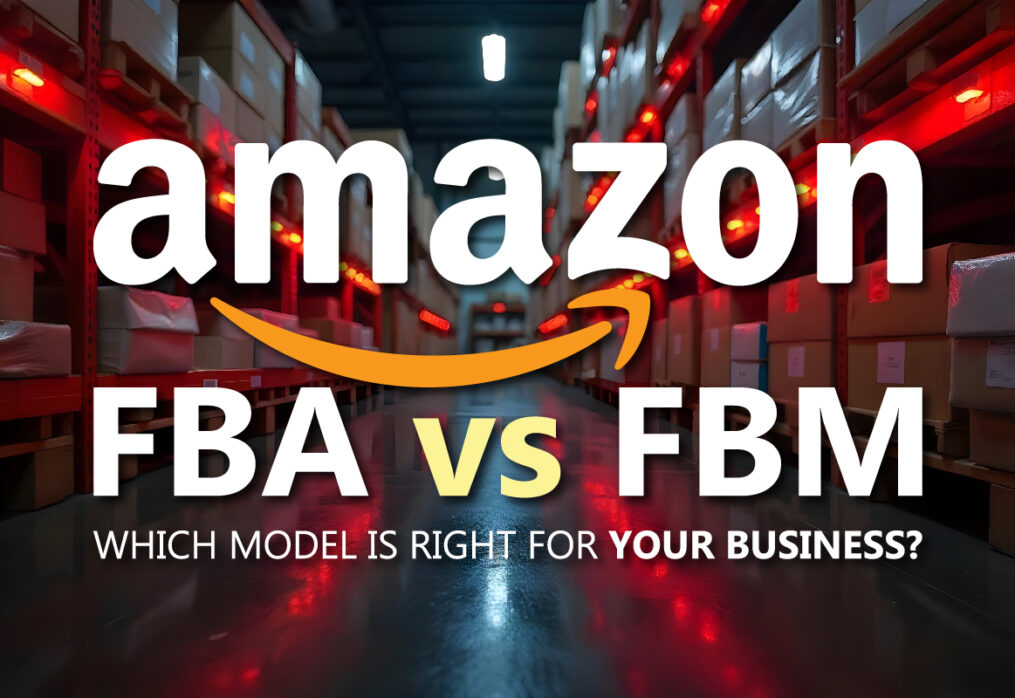Choosing the right fulfillment strategy can make or break your Amazon business. You’re not alone if you’ve ever wondered whether Amazon FBA (Fulfilled by Amazon) or FBM (Fulfilled by Merchant) is the best fit for your operations. At Velocity Sellers, we understand that optimizing your sales strategy on Amazon is key to scaling efficiently, managing costs, and boosting profits. Let’s look at the pros, cons, and key differences between Amazon FBA vs. FBM to help you determine the most suitable path for your business.
Amazon FBA vs. FBM: What Are They?
When considering “Amazon FBA vs. FBM,” it’s crucial to understand what each fulfillment model offers. Amazon FBA (Fulfilled by Amazon) allows sellers to send their products directly to Amazon’s fulfillment centers, where Amazon handles storage, packing, shipping, customer service, and returns. In contrast, Amazon FBM (Fulfilled by Merchant) means sellers manage inventory, packing, shipping, customer service, and returns.
Understanding how these two models work is fundamental before deciding which best aligns with your business goals. Velocity Sellers is here to help you make a more informed decision.
Key Differences Between Amazon FBA vs. FBM
There are distinct differences between Amazon FBA and FBM, and each model caters to different seller needs. Let’s explore these key differences:
- Logistics and Fulfillment: Amazon FBA offers a hands-off approach by taking care of inventory, packing, and shipping, whereas FBM places all fulfillment responsibilities on the seller. FBA is often a good fit for those who want to focus on scaling, while FBM gives more control to sellers who prefer hands-on management.
- Costs Involved: With FBA, you pay for storage and fulfillment fees, which include picking, packing, and shipping services. FBM sellers only need to cover shipping and logistics costs and might also face increased labor expenses and warehousing fees.
- Customer Service: Amazon provides all customer service and handles returns under FBA, ensuring a streamlined experience for buyers. FBM sellers, however, have to manage customer inquiries, complaints, and returns on their own.
- Prime Eligibility: FBA products automatically qualify for Prime shipping, increasing your chances of reaching Prime customers. FBM sellers can qualify for Prime via Seller-Fulfilled Prime (SFP), though it requires adherence to strict guidelines and meeting Amazon’s high standards.
Pros and Cons of Amazon FBA
If you are leaning toward Amazon FBA, let’s examine the advantages and drawbacks of Amazon FBA vs. FBM.
Pros of Amazon FBA
- Hands-Off Fulfillment: Amazon handles all logistics, from storing your inventory to packaging and delivering it. This hands-off approach means you can save valuable time and focus on growth and scaling your business.
- Prime Eligibility: When considering Amazon FBA vs. FBM, one of the greatest advantages of FBA is automatic eligibility for Amazon Prime. This allows your products to reach a wider audience and attract more Prime members who value fast free shipping.
- Customer Service and Returns: Amazon handles customer inquiries and returns, giving you peace of mind and allowing you to prioritize other aspects of your business.
- Increased Buy Box Chances: FBA listings often have a better chance of winning the Buy Box, which means increased visibility and higher sales potential.
Cons of Amazon FBA
- Costs and Fees: FBA fees can add up, including storage fees (especially during peak seasons), picking, packing, and shipping fees. If not managed properly, these costs may eat into your profit margin.
- Lack of Control Over Inventory: Since Amazon stores your inventory, you need more control over how products are handled and stored. Mismanagement at the fulfillment center can lead to issues such as damaged items or lost inventory.
- Long-Term Storage Fees: Products that do not sell quickly can accrue long-term storage fees, significantly increasing your expenses if you hold slow-moving items.
Pros and Cons of Amazon FBM
Look at the FBM side of the “Amazon FBA vs. FBM” debate. FBM offers advantages and disadvantages that may more closely align with specific business needs.
Pros of Amazon FBM
- Greater Control: When selling via FBM, you maintain complete control over inventory, shipping, and customer service, allowing you to make real-time adjustments and optimize operations based on your specific preferences.
- Lower Fees: FBM typically results in lower fees because there are no FBA storage or fulfillment costs. This is a significant advantage for sellers with warehousing capabilities or who want to reduce fulfillment costs.
- Personalized Customer Experience: With FBM, sellers can personalize packaging and the overall customer experience, which can help build a strong brand identity and customer loyalty.
Cons of Amazon FBM
- No Automatic Prime Eligibility: FBM sellers are not automatically eligible for Prime shipping, which can disadvantage them compared to FBA sellers. Sellers who want to offer Prime must enroll in Seller-Fulfilled Prime, which has strict requirements.
- Responsibility for Logistics: The seller is responsible for all logistics, including packing, shipping, and returns. This can challenge smaller operations or sellers without an established logistics system.
- Customer Service Burden: Unlike FBA, FBM sellers are responsible for providing customer service and managing returns, which can be time-consuming and may distract from growth-related activities.

Amazon FBA vs. FBM: Which Is Better for Scaling Your Business?
The decision between Amazon FBA vs. FBM ultimately depends on your business goals, resources, and logistics capabilities. If you want a hands-off approach to fulfillment and prioritize reaching Prime customers, Amazon FBA might be the best route. However, if you prefer greater control over inventory, lower fees, and have your own logistics system, Amazon FBM could be more suitable.
When to Choose Amazon FBA
- Scaling Quickly: If you’re looking to scale quickly and need help managing a large volume of orders, Amazon FBA is a great option. FBA allows you to focus on growing your product range and marketing without worrying about fulfillment.
- Prime Visibility: Amazon FBA is a straightforward solution for products needing Prime eligibility to stay competitive.
- Lack of Warehousing Facilities: If you don’t have the resources or space to store inventory and ship products, FBA is the obvious choice as Amazon takes over these responsibilities.
When to Choose Amazon FBM
- Niche Products: If you’re selling niche products that may not generate huge sales volumes, Amazon FBM can be more cost-effective as you won’t incur high fulfillment fees.
- Greater Control: If you value having complete control over your inventory and customer experience, FBM is the right fit. With FBM, you can handle products according to your brand standards.
- Lower Costs: For businesses that already have a fulfillment infrastructure or the ability to manage their logistics cost-effectively, FBM can result in better profit margins.
Amazon FBA vs. FBM: Impact on the Buy Box
One significant factor when evaluating Amazon FBA vs. FBM is the impact on winning the Buy Box. The Buy Box is crucial for generating sales, as most buyers purchase directly from it. FBA tends to have a better chance of winning the Buy Box due to the Prime badge and Amazon’s reputation for fast shipping and excellent customer service.
FBM sellers can still win the Buy Box, particularly if they have excellent seller metrics, competitive pricing, and fast shipping. However, competing with FBA sellers can be challenging without the Prime badge, especially for competitive products.
Cost Comparison: Amazon FBA vs. FBM
Cost is among the biggest deciding factors for many sellers regarding Amazon FBA vs. FBM. With FBA, sellers must pay for storage fees, fulfillment fees, and additional costs such as long-term storage. While these services provide convenience, they do come at a cost.
FBM, on the other hand, requires sellers to manage their warehousing, labor, and shipping. The costs can be lower if you have a well-managed logistics system, but the burden of managing operations can be significant, especially as your business grows. Ultimately, the right choice will depend on how well you balance these costs with your business capabilities.
Top 3 Amazon FBA Issues & How to Fix Them
When working with Amazon FBA, sellers face some common issues. Here are the top three Amazon FBA issues and how you can fix them:
- Inventory Storage Fees: Long-term storage fees can quickly increase, especially if you have slow-moving inventory. To address this, consider using Amazon’s Inventory Performance Index (IPI) to manage your stock levels effectively and remove unsold inventory before it incurs extra fees. Regularly reviewing your inventory performance and planning promotions can help clear out older stock.
- Lost or Damaged Inventory: Occasionally, inventory may get lost or damaged at Amazon’s fulfillment centers. To fix this, regularly audit your inventory and use Amazon’s reconciliation tools to identify discrepancies. If you find missing or damaged items, submit a claim to Amazon for reimbursement.
- Customer Returns: FBA handles customer returns, but managing the return rate is essential to maintain profitability. Reduce return rates by optimizing product descriptions, providing accurate images, and ensuring your product meets customer expectations. Proper quality control and transparency in listings can prevent customer dissatisfaction.

Managing Amazon Inventory: Choosing Between FBA and FBM
Inventory management is a critical component of running a successful Amazon business. Choosing between Amazon FBA and FBM can have a significant impact on how you manage your inventory:
- FBA Inventory Management: With FBA, Amazon stores your inventory, meaning you must ship your products to Amazon’s fulfillment centers. This requires careful planning to ensure you have the right stock to meet demand without incurring high storage fees. Tools like Amazon’s Inventory Planning can help you maintain the right balance.
- FBM Inventory Management: FBM allows you to keep full control over your inventory, which means you can store products in your warehouse with a third-party logistics provider. This can give you more flexibility in managing stock levels but also requires more hands-on involvement to ensure orders are fulfilled on time.
The choice between FBA and FBM for inventory management depends on how much control you want and whether you have the infrastructure to support your inventory needs. FBA can simplify logistics, while FBM gives you full control over stock management.
Full Service Amazon Management: Benefits of Using FBA vs. FBM
Full-service Amazon management can help streamline your operations and boost sales. Let’s explore the benefits of using FBA vs. FBM for full-service Amazon management:
- FBA for Full Service Management: With FBA, Amazon handles nearly every aspect of fulfillment, including storage, packing, shipping, and customer service. This means you can focus on growing your business without getting bogged down by operational tasks. FBA is ideal for businesses that want to scale quickly and take advantage of Amazon’s Prime network.
- FBM for Full Service Management: FBM, on the other hand, gives you complete control over the fulfillment process, allowing you to manage every aspect of your brand’s experience. This can be particularly beneficial if you have unique packaging needs or want to provide a personalized experience for customers. Full-service management with FBM requires a well-organized logistics system, which can lead to greater brand loyalty and cost savings.
At Velocity Sellers, we help our clients choose the best fulfillment model based on their needs. Whether you want to leverage Amazon’s vast logistics network with FBA or maintain full control of your brand with FBM, our team provides the expertise to help you succeed.

The Best Model for Your Business: Amazon FBA vs. FBM
The decision between Amazon FBA and FBM is not black and white—it’s about finding the right balance for your unique business needs. At Velocity Sellers, we encourage clients to consider scalability, cost, and logistics before deciding.
- For high-volume sellers, Amazon FBA is often the preferred model due to its scalability and ability to easily reach Prime customers.
- For Smaller or Niche Sellers: Amazon FBM can offer cost savings and greater control, making it a viable choice for businesses with existing logistics solutions or those selling specialty products.
- Hybrid Approach: Many successful Amazon sellers use a hybrid approach utilizing FBA and FBM. This approach allows you to take advantage of the benefits of FBA while controlling specific products or segments of your inventory.
Conclusion: Which path will you take for Amazon FBA vs. FBM?
Ultimately, the choice between Amazon FBA vs. FBM depends on your business model, goals, and resources. Amazon FBA provides convenience, scalability, and access to Prime customers, making it a great choice for scaling quickly. On the other hand, Amazon FBM offers greater control, lower costs, and flexibility for those who want to handle fulfillment in-house.
Here at Velocity Sellers, we have extensive experience working with both FBA and models and can help you determine the best fit for your business. Whether you are looking to scale rapidly with FBA or keep a close eye on your logistics with FBM, we can provide guidance to maximize your sales potential on Amazon.
Choosing the right fulfillment method could be the turning point for your Amazon business. If you still need to decide whether FBA or FBM is right for you, contact us at Velocity Sellers. We’d be happy to help guide you to your accessible decision for your unique needs.
Are you ready to take the next step in your Amazon journey? Whether you’re leaning towards FBA, FBM, or a hybrid approach, Velocity Sellers has the expertise to help you thrive.



